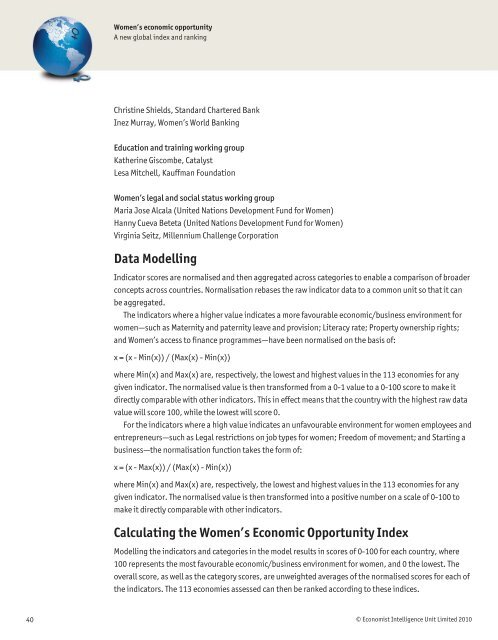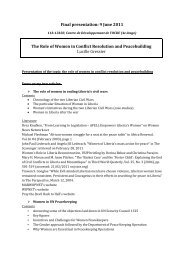Women's Economic Opportunity Index - Economist Intelligence Unit
Women's Economic Opportunity Index - Economist Intelligence Unit
Women's Economic Opportunity Index - Economist Intelligence Unit
- No tags were found...
You also want an ePaper? Increase the reach of your titles
YUMPU automatically turns print PDFs into web optimized ePapers that Google loves.
Women’s economic opportunityA new global index and rankingChristine Shields, Standard Chartered BankInez Murray, Women’s World BankingEducation and training working groupKatherine Giscombe, CatalystLesa Mitchell, Kauffman FoundationWomen’s legal and social status working groupMaria Jose Alcala (<strong>Unit</strong>ed Nations Development Fund for Women)Hanny Cueva Beteta (<strong>Unit</strong>ed Nations Development Fund for Women)Virginia Seitz, Millennium Challenge CorporationData ModellingIndicator scores are normalised and then aggregated across categories to enable a comparison of broaderconcepts across countries. Normalisation rebases the raw indicator data to a common unit so that it canbe aggregated.The indicators where a higher value indicates a more favourable economic/business environment forwomen—such as Maternity and paternity leave and provision; Literacy rate; Property ownership rights;and Women’s access to finance programmes—have been normalised on the basis of:x = (x - Min(x)) / (Max(x) - Min(x))where Min(x) and Max(x) are, respectively, the lowest and highest values in the 113 economies for anygiven indicator. The normalised value is then transformed from a 0-1 value to a 0-100 score to make itdirectly comparable with other indicators. This in effect means that the country with the highest raw datavalue will score 100, while the lowest will score 0.For the indicators where a high value indicates an unfavourable environment for women employees andentrepreneurs—such as Legal restrictions on job types for women; Freedom of movement; and Starting abusiness—the normalisation function takes the form of:x = (x - Max(x)) / (Max(x) - Min(x))where Min(x) and Max(x) are, respectively, the lowest and highest values in the 113 economies for anygiven indicator. The normalised value is then transformed into a positive number on a scale of 0-100 tomake it directly comparable with other indicators.Calculating the Women’s <strong>Economic</strong> <strong>Opportunity</strong> <strong>Index</strong>Modelling the indicators and categories in the model results in scores of 0-100 for each country, where100 represents the most favourable economic/business environment for women, and 0 the lowest. Theoverall score, as well as the category scores, are unweighted averages of the normalised scores for each ofthe indicators. The 113 economies assessed can then be ranked according to these indices.40© <strong>Economist</strong> <strong>Intelligence</strong> <strong>Unit</strong> Limited 2010




